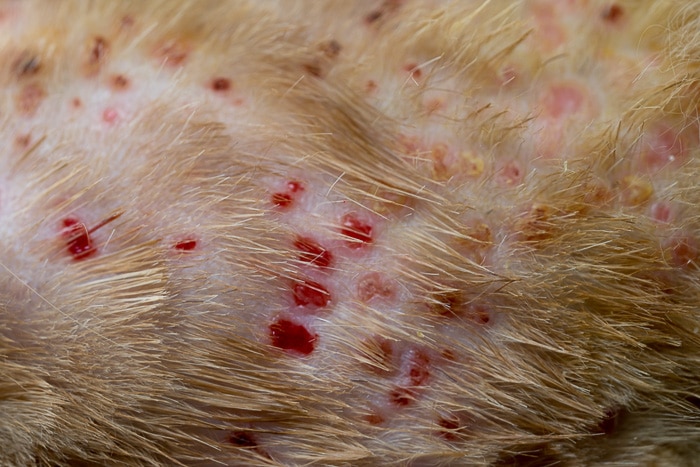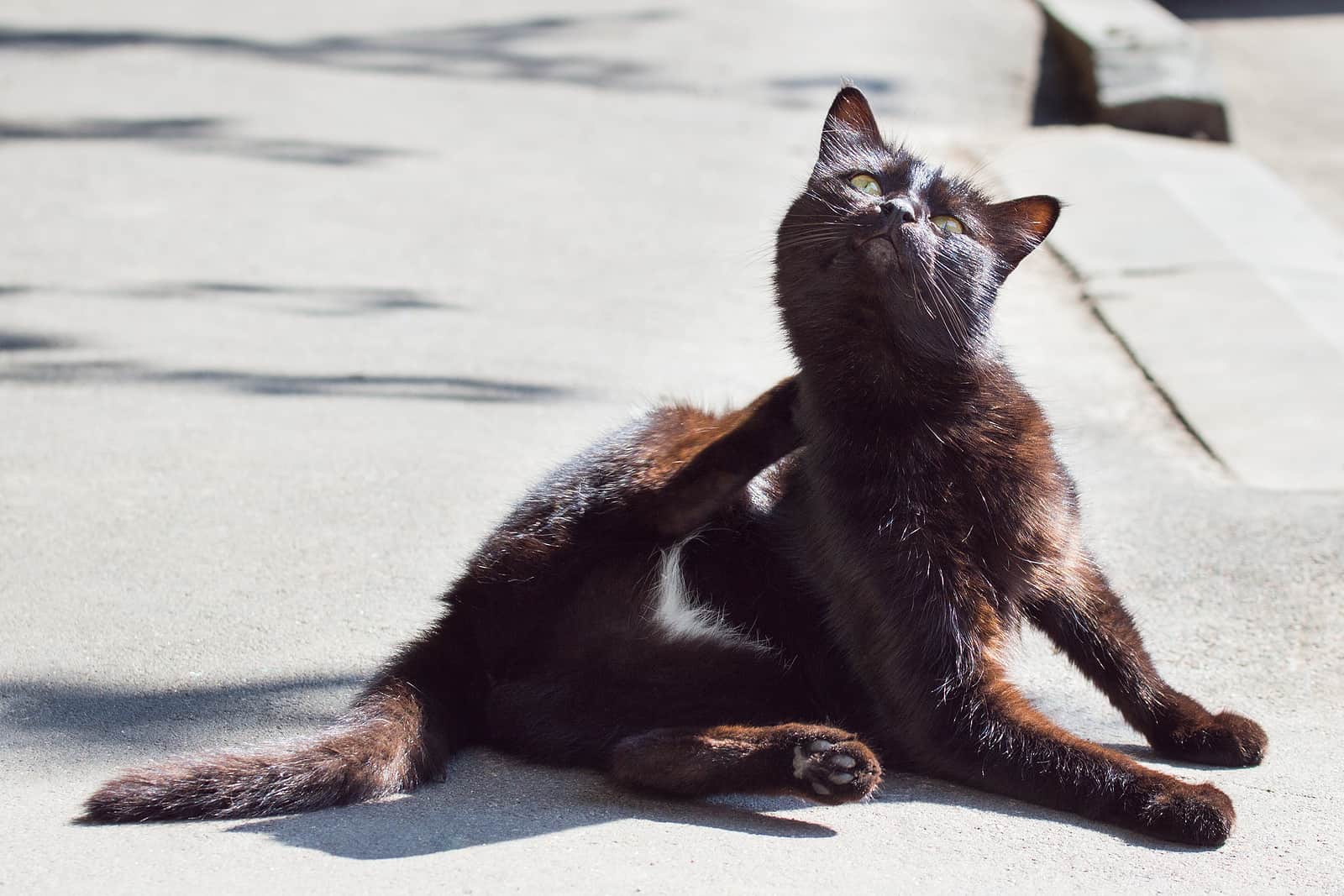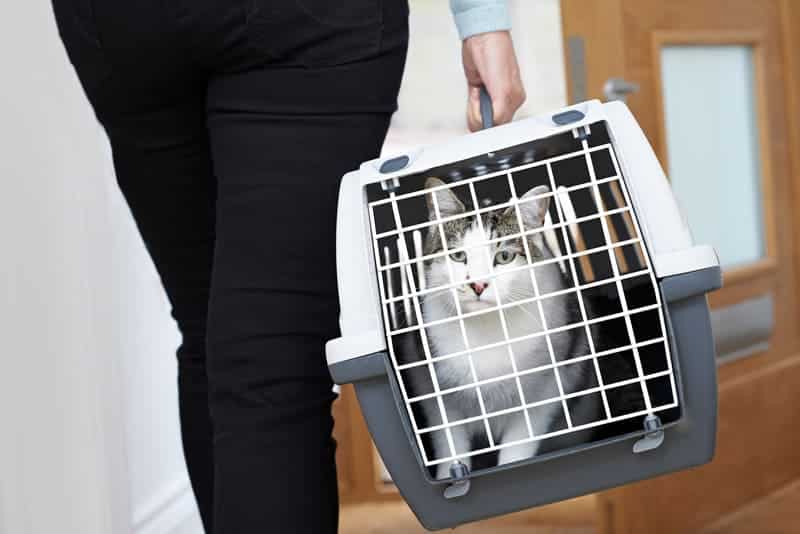A sad, but true realization is that sometimes our precious pets get sick. They’re no stranger to any of the sicknesses that we sometimes come down with. Especially allergies. Allergies are some of the most frustrating and overall annoying conditions that we experience for a variety of reasons. Unfortunately, our feline friends must endure them also.
One awful caused by different allergens found throughout the home, food-induced, or from natural causes those sweet little kitties are suffering from is . This can be caused by a few different things but know that it is considered to be one of many serious .
Most pet owners avoid these conversations in hopes that it may never happen to them, but if you’ve made it to this article, we’re guessing that your cat has started to experience some symptoms of a rash or irritation. In this case, he or she may have . Don’t worry too much yet! The good news is that it’s totally treatable, the other good news is that our experts have experienced this first hand. Meaning it hits home . . . hard. The research provided in this article is thorough and all about making your cat’s experience with the least triggering as possible. So continue reading and learn everything you need to know.
What is ?
First things first, what even is it?! Well, if you’ve had a dog or know someone who’s had a dog they’ve probably had an experience with hot spots at least once in their lives (seriously, ask around). If you’re familiar with this condition, then understanding will be a bit easier a concept to grasp. If you’re not, no worries, we’re here to get to the bottom of it for you.
is a that is essentially an caused by environmental allergens, food allergies, , and other autoimmune diseases. Seasonal allergies and environmental allergies include some or all of the following:
- Pollens
- House dust
- Molds
- Even allergies to other pets!
As we can see, it’s possible for our kitties to be allergic to anything just as much as it is for us. Being aware of this will help to make finding a solution that much easier.
Essentially, the will cause throughout your feline’s . These are called and they’re found in a variety of sizes and locations throughout the cat’s body. The more these are irritated, the bigger and more scabby they become. With something like this, it’s important to catch it right away to prevent further irritation. In order to do that watch out for the .
What Are the of ?
Knowing exactly what to look out for with any condition of animals should be at the top of your list. A clinical sign is the indication of a medical fact or characteristic. These signs are normally spotted before or during an examination. It’s important for pet owners to be able to spot of before their next vet appointment. Most of the symptoms, if caught early enough, can be treated from home. See treatment options later in the article.
If you’ve come to this article because you’ve noticed throughout your cat’s body you probably already have some basic knowledge of what is, if you’re here just to learn more, then here’s a list of the most common and known symptoms.

Red, Crusty Bumps Were Found Throughout the Cat’s Body
It’s important to note that the bumps can start very small and be hidden in your cat’s fur. Therefore, it’s sometimes more evident when owners can feel for the bumps rather than search for them. Not to be confused with a normal scab on an adventurous kitty, these bumps are usually localized or widespread and are usually swollen and feel very scabby. Feeling a bit different than a regular scab from an outdoor fight or rubbing against something sharp.
If you’re feline has come down with this they will have not only of the but normally bits of . The condition can leave the feeling hot and itchy causing cats to scratch and bite in order to relieve the pain.
Hair loss
Results from the licking, , and often show themselves in the form of hair loss. If you’re finding chunks of your cat’s hair throughout the house, odds are she is scratching or licking so much that she’s pulling it out herself. At this point, the condition might have taken another turn and applying treatment more often might help. At some point, you may have to contact the veterinarian to get some medical-grade steroids.
GI symptoms
This isn’t always a symptom, but can sometimes show up. If the was caused by food or something else that your feline ate, GI symptoms can also be common. These symptoms will probably be something as simple as a loose stool but are important to look out for when trying to find the reason for the .
As you can see, the symptoms of are quite obvious and seem to show themselves in a variety of ways. This is important to recognize when self-diagnosing an animal without a vet’s clarification. This condition usually presents itself in a myriad of obvious ways. If your cat has been showing any of these symptoms it’s important to treat them immediately in order to prevent further damage. If you’re not sure what’s going on it’s always vital to get a Vets opinion before treating.
When Did My Cat Contract This S?
is caused by a variety of different surroundings. The most common and most frequently seen is actually to bites. A can cause very serious reactions in some felines. This is why treating cats for fleas is super important. Understanding and knowing that even indoor cats can still get fleas is vital to protecting and keeping your cat safe.
Along with allergies, the plethora of other allergies that can provoke this are far and few between. Here is a breakdown of the different allergens that could potentially be a harm to your kitty’s :
Fleas
First and for most – fleas – bites can become very serious. If a cat doesn’t have a specific to fleas, then the reactions are usually mild and come with little scratching. Unfortunately, those sweet feline friends who do actually have an to fleas are in for a whole different ball game. A more severe reaction can come about from even one single . So imagine a cat with a who has a . Yikes.
Food Allergies
As we know, fleas are definitely not the only way that your felines can come down with a case of this . Therefore, if you notice or other symptoms but have been avid about treating your cat for fleas, it’s important to understand all of the different allergies and where they usually happen. With food allergies, the most common spot of to show itself is on the lower abdomen, face, eye area, and around the neck. If this is the case, it’s not only important to treat the , but to also get to the cause of the underlying issue; What is your feline friend reacting to? testing is a simple procedure that can be done by a veterinarian.
Pollen
Another that cats can come down with is pollen. Just like people, pollen can affect cats. It’s important to know that even if your cat doesn’t go outdoors they can still have a pollen ! It’s actually been found that for both humans and animals pollen allergies increase when indoors. Pollen can be tracked through your home from your clothes, shoes, and so on. This can then cause it to be trapped inside with no windows or doors to get out. A pollen will normally affect a cat’s inner thighs and forelegs, lips, neck, and possibly the abdomen. Depending on the severity of the condition, and if at-home treatments aren’t working, it might be time to call the vet and get your kitty on a steroid.
Autoimmune Disease
As previously stated, an autoimmune disease can equally cause as any of the other allergens mentioned above. Autoimmune reactions show inflammation in different areas compared to the previously discussed allergens. With autoimmune diseases, inflammation can normally be found on or surrounding the feline’s nipples or around the eyes, and edges of the ears. It can also even be spotted on the nail beds.
Parasites
Parasites besides fleas include things like tapeworm and roundworm. These infections are usually quite common, especially in outdoor cats. With that said, indoor cats can also have a case of parasites. In this case, is often found around the tail and neck.
With an understanding of the different allergens that can possibly cause this , it’s important to realize that most of the location of the can help determine what type of it is. Once the has been determined it’s important to take your cat to the vet and get proper testing to prevent future outbreaks.
Does a Vet Have to Diagnose ?
If you notice extra licking and from your feline friend, it’s important to check with your vet. A vet can give the proper diagnosis and prevent something more serious. When diagnosing, the vet will normally use that are visible or have been noticed by you, while also pulling the cat’s medical record. They use this to compare different options that may be causing irritation.
It’s often easier for a veterinarian to understand the location of the outbreak. Which in turn can let them quickly decide what the cause of this was. Therefore, having a vet diagnose the condition is important and could potentially save your cat from something serious. The vet can give pet owners the proper diagnosis and give advice on how to move forward with treatment. The most common practice is to remove what is causing the allergens.
Treatment Options
If your cat was diagnosed by a Veterinarian, the treatment options are often prescribed directly by the doctor. With that in mind, it’s important to stick to the exact advice given by the Vet. They may also recommend different ideas to get rid of the allergen altogether in order to prevent future outbreaks.
The main objective in treating is to reduce the your cats have been showing. There are a variety of different methods of doing this before medication is given to the cat. Although there are a variety of methods that will help soothe the while the pet owner is dealing with the underlying condition. If you suspect that the cat has a it’s important to immediately switch to a hypoallergenic food trial and see if the symptoms persist.
Your Veterinarian may also prescribe anti-inflammatory drugs in order to get your feline’s back under control. Considering this is normally painful, it might be the best way to help your cat. Corticosteroids are the most commonly prescribed drug to ease the sensation while treatment takes effect. These steroids can be given locally and normally for this type of which is the best option. Applied directly to the area where the cat is having the most reaction, these steroids will help to decrease inflammation and help to reduce and other uncomfortable feelings.
Here are a few treatment options that our experts recommend for helping ease your cat’s pain from :
This non-stinging formula is perfect for cats suffering from mild cases of . This spray is not only super easy to apply but has also been known to reduce inflammation, swelling, , and redness which will stop , scratching, and biting.
Hydrocortisone works by activating the natural substances in the body which reduce swelling, redness, and . Using hydrocortisone in cats works just the same and will hopefully reduce the and burning that comes with the , while pet owners figure out what exactly is causing this .
This medicated spray is both fast-acting and veterinarian recommended. If your cat suffers from seasonal allergies and you think there’s about to be a Miliary Dermatitis outbreak, it’s important to keep this handy little bottle in the house. Relieve symptoms in your cat with this easy-to-apply spray before the condition worsens.
This alcohol-free formula relieves , redness, and . Infused with both aloe and vitamin E (natural soothing ingredients), this is the perfect spray for pets. It works for both dogs and cats and will seriously soothe their allergic reactions.
Wipes are a great alternative to spray. Sometimes it can be a bit intimidating for the cats when that spray bottle comes out. Therefore, wipes are a great alternative. If your feline friend is lovey-dovey and will absolutely love the wipe-down, then these are perfect for you.
Conclusion
is a that can be easily treated. The underlying issue of this is most often related to an . Figuring out exactly what this is can be a difficult task. It’s often easier to figure out by focusing on where the prevents itself.
Getting rid of the allergen itself is probably the top form of treatment but treating your cat with different ways to help relieve symptoms is also super important. can affect any cats at any time in their lives, therefore understanding and knowing the and symptoms to look out for could potentially help you in the future. If your feline friend is scratching, or licking their hair off, it’s important to think about the different treatment options laid out in this article while also learning exactly what allergen your cat may have. There are a variety of different symptom relief options on the web, but our experts narrowed the search down for you. With the topical sprays and wipes provided in this article, helping your cat relieve symptoms at home just became that much easier.
If symptoms are still persisting and don’t seem to be getting better it’s important to take your pet to the Veterinarian. The Veterinarian can help by determining what the is and steps to take to prevent future outbreaks. While also possibly prescribing more intense steroids to help relieve symptoms.
is a totally treatable that affects cats due to allergies or insect infestations. Preventative measures are one of the best ways to prevent flare-ups with this disease. The biggest takeaway for preventing and treating is to get to the bottom of the overlying and remove it from the cat’s living area. Also, taking preventative measures to treat fleas with a topical ointment or collar is highly encouraged.







